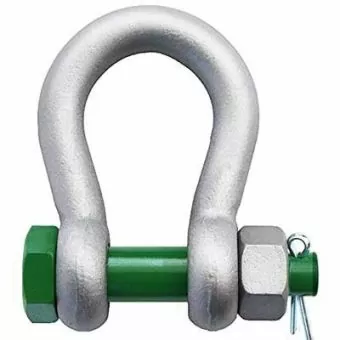Shackles remain one of the most widely used tools in rigging and lifting operations. From construction sites to industrial plants, these small but critical components link slings, hooks, and loads together. However, even the strongest lifting shackles can fail if misused. Many workplace accidents stem from preventable errors in the selection, application, and maintenance of shackles. Understanding common misuses helps industrial teams avoid costly downtime and safety hazards.
Side Loading Mistakes
Shackles are designed to carry loads along their centerline. When operators apply loads at an angle—known as side loading—the working load limit (WLL) decreases significantly. Even a slight side pull can create bending forces that the shackle body and pin are not engineered to handle.
For example, rigging crews sometimes connect slings at improper angles, assuming the shackle will hold. Over time, this misuse leads to the distortion of the bow or pin. Teams should always follow manufacturer guidelines on angle ratings and use appropriate multi-leg sling configurations to avoid side loading altogether.
Wrong Pin Types
Another standard error is selecting the wrong pin type for the application. Screw pin shackles are convenient for temporary or frequently adjusted connections, but they can loosen in high-vibration environments. Bolt-type shackles, secured with a nut and cotter pin, provide better security for long-term or dynamic applications.
When workers interchange pin types without considering load conditions, they increase the risk of pins backing out or failing under stress. Choosing the correct pin style ensures that rigging shackles perform reliably throughout the operation.
Using Damaged Shackles
All too often, teams continue using shackles that show signs of damage. Bent pins, stretched eyes, corrosion, or cracks compromise strength and can lead to sudden failure during a lift. Some operators mistakenly believe a lightly damaged shackle can handle reduced loads. In reality, any visible defect is cause for immediate removal from service.
Replacing damaged gear with heavy-duty shackles designed for the load ensures compliance with safety standards and protects both personnel and equipment. The cost of replacement is always lower than the consequences of an accident.
Lack of Regular Inspection
Routine inspection is critical, yet often overlooked in fast-paced industrial environments. Shackles in daily use should be checked before every lift for thread condition, pin security, and signs of deformation. Periodic in-depth inspections should also measure wear on pins and bodies, ensuring components remain within manufacturer tolerances.
Failing to establish inspection routines leads to unnoticed wear and progressive weakening. Proper inspection programs extend service life and help teams identify issues before they escalate into failures.
Conclusion – Avoid Preventable Rigging Issues
Shackles may seem simple, but their proper use determines the safety of entire lifting operations. Avoiding sideloading, selecting the right pin type, retiring damaged gear, and committing to regular inspections ensure shackles perform as intended. For dependable rigging shackles and heavy-duty shackles engineered to meet industrial demands, Murphy Industrial Products, Inc. offers a comprehensive selection built to last. When sourcing crane shackles, always choose hardware that matches the load requirements and is backed by proven reliability.



